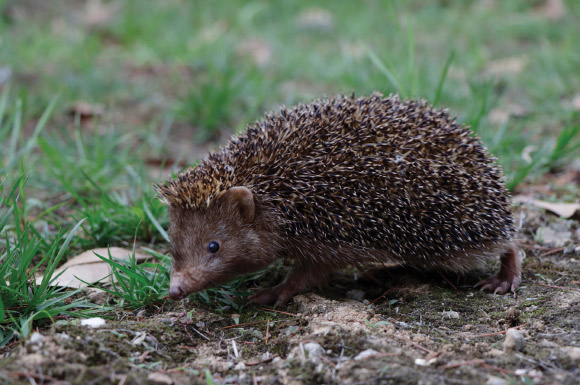If you cannot find the answer you are looking for, please contact us.
Eastern forest hedgehog

Described in 2018 by He et al. It is found only in eastern Heilongjiang, China, making it highly range-restricted. It is distinguished by subtle skull and tooth characteristics that separate it from all other Mesechinus species.
Taxonomy
| Kingdom: | Animalia |
| Phylum: | Chordata |
| Class: | Mammalia |
| Order: | Eulipotyphla |
| Family: | Erinaceidae |
| Genus: | Mesechinus |
| Species: | Mesechinus orientalis |
Natural range & habitat
The Eastern Forest Hedgehog is endemic to China and is known only from a restricted area in eastern Heilongjiang Province. It inhabits temperate forest regions, including mixed coniferous and broadleaf forests, and appears to prefer areas with dense understory vegetation and abundant ground litter. The species is found in relatively cool, moist environments, often at moderate elevations, and relies on natural cover for nesting and foraging. Its range is entirely separate from that of other Mesechinus species, and it does not appear to overlap with related hedgehogs. Detailed information about its exact distribution, altitude range, and habitat preferences is still lacking due to the limited number of field studies conducted since its discovery.
Physical traits
The Eastern Forest Hedgehog is similar in size to other Mesechinus species, with an estimated body length of around 20 to 25 centimeters and weights likely ranging from 500 grams in spring to close to 1 kilogram before hibernation. It has a dense coat of spines that are banded in shades of brown and cream, with a soft undercoat of fur on the face, flanks, and underside. The head is elongated with a pointed snout, and the ears are small and rounded. The fur on the face and underparts is generally dark brown to greyish. The species is distinguished from related hedgehogs by subtle cranial and dental differences, which were key in its scientific description. Sexual dimorphism has not been documented, and seasonal changes in body condition are assumed to be similar to those of other temperate hedgehogs.
Behavior & lifestyle
Almost nothing is known about the behavioral ecology of the Eastern Forest Hedgehog from direct observation. Based on the habits of closely related species, it is likely nocturnal and solitary, resting during the day in nests located under dense vegetation, in hollow logs, or in self-dug burrows. In its temperate forest habitat, it probably undergoes hibernation during the winter months, retreating to an insulated nest lined with leaves and other plant material. It is expected to be an active forager, covering significant ground each night in search of food, and to show seasonal changes in activity patterns depending on temperature and prey availability.
Communication
No specific studies have been conducted on communication in the Eastern Forest Hedgehog. It is presumed to rely primarily on olfactory cues for territory marking and mate recognition, as in other hedgehogs. Acoustic signals are likely limited to hissing, snorting, or grunting during close encounters with conspecifics or when threatened. Self-anointing behavior has not been documented but may occur, as it is widespread among hedgehog species. Given its nocturnal habits, visual communication is probably minimal.
Diet in the wild
The natural diet of the Eastern Forest Hedgehog has not been recorded, but it is presumed to be primarily insectivorous, feeding on beetles, caterpillars, earthworms, and other ground-dwelling invertebrates. It may also take small vertebrates, bird eggs, and seasonal plant matter such as berries or fallen fruit. Its forest habitat likely provides a diverse prey base within the leaf litter and soil. Seasonal variation in diet is probable, with greater consumption of plant matter during late summer and autumn when fruits and berries are more available.
Reproduction & life cycle
There is no published data on the reproduction of the Eastern Forest Hedgehog. By analogy with related Mesechinus species, breeding probably occurs in late spring or early summer, shortly after hibernation ends. Gestation is likely around 35 to 40 days, and litters probably consist of three to six hoglets born in a concealed nest. The young would be born blind and with soft spines, with eyes opening after about two weeks, and weaning occurring by four to six weeks. Sexual maturity is expected to be reached within the first year. Lifespan in the wild remains unknown but may be similar to other hedgehogs at three to five years.
Threats & conservation status
The Eastern Forest Hedgehog has not yet been evaluated by the IUCN due to its recent description. Its restricted range could make it vulnerable to habitat loss and fragmentation, especially from logging, agricultural expansion, and infrastructure development. Road mortality may also pose a threat in areas where roads pass through or near its forest habitat. The use of pesticides in surrounding agricultural lands could indirectly reduce prey abundance and expose the species to toxic substances. Because so little is known about its population size, distribution, and ecology, it is difficult to assess its conservation status accurately. Targeted field studies are urgently needed to fill these knowledge gaps.
This species in captivity
The Eastern Forest Hedgehog is not known to be kept in captivity, either in the pet trade or in zoological collections. No captive breeding programs exist, and there are no records of the species in wildlife rehabilitation centers. Its specialized habitat requirements and restricted distribution suggest that it would be difficult to maintain in captivity without detailed ecological knowledge. Conservation for this species must therefore focus on habitat protection, field research, and raising awareness about its existence and potential vulnerability.
